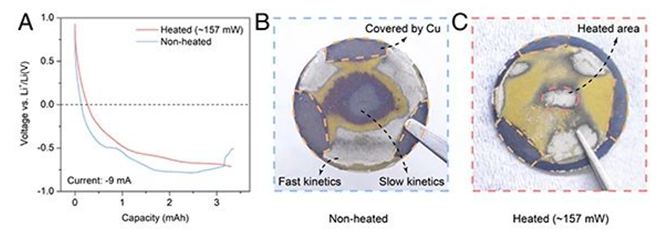During the long-cycle cycle, the reversible capacity of the lithium-ion battery will continue to decrease due to the reduction of active materials, the precipitation of metal lithium, the continuous consumption of electrolyte, the increase of internal resistance and thermal runaway. Among them, the lithium evolution phenomenon of the graphite negative electrode is the most important cause of battery capacity degradation and internal short circuit.
By continuation from our last technical article, now we are going to explain more about this phenomenon below:
Based on the study of Li-Cu batteries, the author hopes to prove that Li-graphite batteries can also undergo a lithium evolution reaction at a potential higher than 0 V (vs. Li0/Li+). In order to minimize the effects of kinetics, the researchers reduced the applied constant current to -10 mA (approximately C/25). The three voltage platforms in Figure 4B correspond to different lithium insertion stages of graphite. At the last stage of the third voltage platform, the heating device is turned on (Figure 4C), and the battery voltage increases rapidly due to the increase in the balance electrode potential and the reduction over potential. Then as the graphite lithium intercalation reaction continued, the voltage began to drop. When the voltage drops to 25 mV, the slope of the voltage curve drops significantly (as shown in Figure 4E), which is completely different from the unheated graphite charging curve, which may mean that lithium ions begin to deposit and precipitate lithium metal. When the voltage drops to 15 mV, the applied current is removed (the gray arrow in Figure 4B). At this time, the voltage suddenly increases to 72 mV due to the increase in the concentration of lithium ions between the graphite particles and in the electrolyte. This is due to the dissolution of lithium and the further intercalation of lithium in the incomplete intercalation part between graphite layers. After the voltage stabilizes to 85 mV, the constant current is reapplied for a period of time and then removed again, cyclically. During the whole process, the potential of the graphite electrode always remains above 0 V (vs. Li0/Li+). It can be seen from the temperature curve in Figure 4D that the temperature change trend of the system is very similar to that of the Li-Cu electrode. The reason for the temperature drop is the heat dissipation caused by the deposition of lithium metal. When the applied current is removed, the dissolution and the further intercalation of lithium between the graphite layers make the temperature of the battery rise. After the experiment, the precipitation of metallic lithium can also be seen in the central area of the graphite pole piece, confirming that the uneven temperature distribution inside the battery can indeed cause the graphite anode to undergo lithium precipitation at a potential higher than 0 V (vs. Li0/Li+) reaction.

Figure 5. Lithium evolution on graphite anode under fast charge conditions
(c) Under heating conditions, the photo of the graphite negative electrode after fast charging, the central area is fully intercalated with lithium and the phenomenon of lithium evolution occurs.
tags :
categories
recent posts
scan to wechat:everexceed
